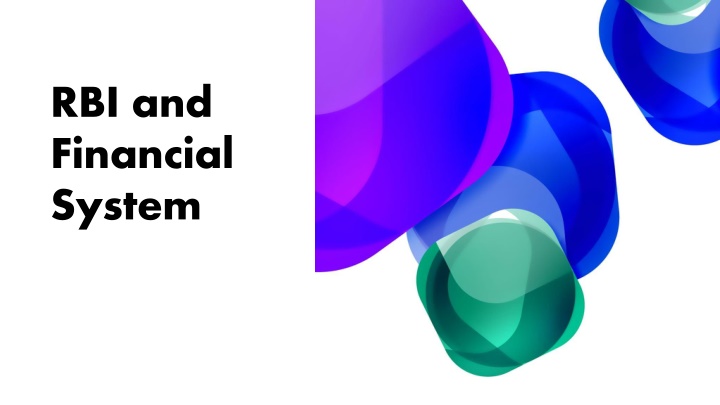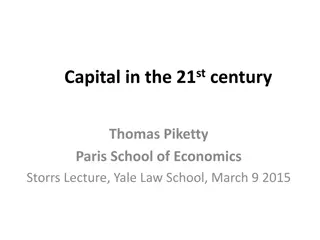Role of Financial System in Wealth Creation
Financial systems play a crucial role in linking savings with investments, mobilizing capital, and fostering economic growth. This system comprises financial institutions and markets that facilitate the flow of funds and provide various investment opportunities. Learning about the components and functions of the financial system helps individuals and organizations make informed investment decisions and plan for wealth creation.
Download Presentation

Please find below an Image/Link to download the presentation.
The content on the website is provided AS IS for your information and personal use only. It may not be sold, licensed, or shared on other websites without obtaining consent from the author.If you encounter any issues during the download, it is possible that the publisher has removed the file from their server.
You are allowed to download the files provided on this website for personal or commercial use, subject to the condition that they are used lawfully. All files are the property of their respective owners.
The content on the website is provided AS IS for your information and personal use only. It may not be sold, licensed, or shared on other websites without obtaining consent from the author.
E N D
Presentation Transcript
RBI and Financial System
Financial System + According to Robertson the primary function of the financial system is to provide a link between savings and investment for the creation of new wealth and to permit portfolio adjustment in the creation of new wealth and to permit portfolio adjustment in the composition of the existing wealth + Financial system helps to mobilize savings, promote capital formation and accelerate economic growth and development. + Financial system thus refers to the structures and services provided by the various constituents related to mobilization and allocation of funds.
Structure/Constituents/Components of the Financial System
+ Financial institutions :- + A financial institution (FI) is a company engaged in the business of dealing with financial and monetary transactions such as deposits, loans, investments, and currency exchange. + Financial institutions encompass a broad range of business operations within the financial services sector including banks, trust companies, insurance companies, brokerage firms, and investment dealers. + Financial institutions can vary by size,scope, and geography.
Functions of Financial System + It serves as a link bety those who save and those who invest. + It offers a variety of instruments and options to savers to earn good return for their savings .Variety and diversity of instruments provide ample choice to the customers. + Money market , capital market and various financial instruments help the corporates, government and others to mobilize capital for investments + Competition among the various institutions increases the supply of capital and reduces the cost of capital required by the investors.This results in increase in production of goods and services + The various financial instruments with different duration,returns enable the corporates to mobilize funds according to their requirements.This also offers variety of investment opportunities to the customers
+ Financial institutions undertake investor education campaigns regularly to create awareness about the services of the financial system.Such campaigns disseminate information about investment opportunities,risks, involved, liquidity, safety norms to be followed. Media both electronic and print are used extensively for this purpose. Through this efforts, financial system induces the savers to save more and enhances the availability of capital to the investors. + Due to advancement of technology, financial system today is able to transfer funds quickly without lapse of time and value.Variety of facilities and quick transfer of funds promotes trade and commerce significantly Credit based payment system of the financial institutions facilitates exchange of goods and services on a larger scale. + + Financial system also helps in minimizing risks and uncertainty and managing them by providing timely information about market fluctuations and their impact on savings and investment. + The efficiency of the financial system in mobilizing and disbursing funds play an important role in the formation and implementation of government s policies.
Characteristics of Financial System + + + It is a complex structure consisting of various components Institutions ,agents ,legal , framework , transactions etc. are the components The components or constituents of the system are inter related and interdependent. It consists of institutions which are organised as well as unorganized Rules and regulations framed by the government and regulatory authorities established are also a part of the system. Provision of various investment opportunities, coverage of risks , promotion of capital formation and enhancing economic growth are essentially the hallmarks of a financial system. + + +
Financial system in India + Financial system in India consists of the money market, capital market and the regulatory bodies namely the Reserve Bank of India and the Securities and Exchange Board of India
Money Market In India + Money market refers to the mechSanism by which funds are transacted for a short period of time. + The important players in the money market are commercial banks,co operative banks, mutual funds. + The leader of the money market is the Central Bank. + The present money market is much more developed than what it was before independence. + At present, the Indian money market is said to the most advanced one amongst the money markets of the developing countries
Capital market in India + Capital market refers to the institutional arrangement to borrow and lend money for a medium and long period of time. + The lenders in the capital market are financial institutions, insurance companies, governments,banks and the borrowers are business units, public corporations, farmers, traders and Governments. + Capital market plays an important role in economic development by accelerating industrial growth. + If the capital market is strong and dynamic , the growth rate gets accelerated at a faster rate.
Structure of Capital Market Capital Market Government Securities Market Financial Intermediarie s Development al Financial Institutions Equity Market Primary market Secondary Market
Role of RBI in Regulating The Financial System Bank Rate Role of RBI Open market Operations Repo rate & Reverse Repo Rate Cash Reserve ratio & Statutory Liquidity Ratio
Qualitative/Selective Credit control + Minimum Margin Requirement + Ceiling on credit + Moral suasion + Differential interest rates + Direct action
Other mechanisms + Liquidity Adjustment Facility + Market Stabilisation Scheme + Marginal Standing facility
Recent Developments in Monetary Management + (1)There is a basic shift in the monetary policy framework i.e. Indirect instruments are preferred over direct instruments of monetary policy. Bank rate, cash reserve ratio and Repo rates have emerged as the main instruments to influence liquidity. + The liquidity management has become better due to the introduction of the Liquidity Adjustment Facility (LAF) and the Market Stabilisation Scheme. Under Liquidity Adjustment Facility (LAF), open market operations and repos are used to ensure monetary stability. + Through LAF, RBI helps the banking sector to balance the supply and demand for liquidity. Both lending and borrowing are undertaken by the Central bank under LAF. + The Market Stabilisation Scheme was introduced in April 2004 to control capital inflows and Increase the stock of government securities held by RBI. + CRR is also deployed by the apex bank as and when necessary h control inflation and absorb the excess liquidity in the system The indirect instruments are market oriented and help in development of the financial market. + (2) Due to an agreement between the Central Government Central Bank in 1997,flhe practice of issuing ad-hoc treasuy bills and automatic monetisation of budget deficit has been discontinued. + (3) Before 1990s CRR and SLR were maintained at a higher level to finance government s expenditure. However, during the j990s, they have been, reduced consistently. At present the CRR is and SLR is 18.5%.
+ (4).Reduction in bank rate in the last five years has led to the decline in interest rates. At present it serves as the reference rate for other rates + (5). Over the years, interest rates have been deregulated by RBI except interest on saving deposits and export credit. Trends in interest rate indicate softening of both lending and deposit rates + However, the reduction in lending rates has not kept pace with the reduction in the deposit rates. Hence in 2003-04 RBI advised the banks to announce a new prime lending rate namely Benchmark Prime Lending Rate (BPLR). + It has to be based on the actual cost of funds, operating expenses a minimum margin to cover regulatory requirement accordingly all banks have announced their BPLR. These rates are lower in the range of 20-200 basis points from their earlier prime lending rates. + (6).Benchmark prime lending rate was replaced by base rate system in 2010.Base rate refers to the minimum interest rate to be charged for all loans + (7).In October 2011, the RBI deregulated interest rate for saving bank account deposits. As per the new policy, banks can offer differential rate of interest for deposits above RS. 1 lakh in savings bank accounts + (8)To make the monetary policy more effective, efforts have been taken by the government to strengthen the security market.The measures include setting up of a system of primary dealers, liquidity support to mutual funds to invest in government securities, ensuring greater transparency in operations, introduction of index, linked bonds, introduction of treasury bills of various maturities.
+ (9)The enactment of the Securitisation Reconstruction of Financial Assets and Enforcement of Security Interest Act 2002 is an important landmark in the ongoing reforms in the financial sector. This act helps the banks s and other institutions to address the problem of non performing assets. Under this act, the creditor is entitled to serve a notice to the debtor to repay the liabilities within 60 days, failing which the creditor can take possession of the secured assets. Detailed guidelines pre given by RBI regarding its implementation. This legislation has helped to improve the recovery position of banks + (10)Technology upgradation has been given considerable attention in the recent yeaFS, At presept the Electronic Funds Transfer facility is available in major cities. All metro centres have the facility Of transfer of funds on the same day basis Efforts are being made by RBI to extend the electronic transfer facility to all locations in the country. + (11) Detailed guidelines have been issued by the Central Bank to Non-banking financial companies regarding the conduct of their business. They have to register with RBI and have to abide by the rules and regulations prescribed by the bank. + To face globalisation successfully it is essential that financial sector adopts international financial s andatds codes. A Standing Committee on International Standards and Codes has been set. Up by the RBI. The Standing Committee, in turn has set up ten advisor committees to examine all the issues related to it.
Thus from 1991 onwards, significant changes have taken in almost all aspects of theo Indian economy. As far as monetary management is concerned, the following changes are noteworthy, + Monetisation of budget deficit by RBI has been delinked. + Interest rate deregulation has been introduced. + The government securities market has been activated through number of measures. + Reduction of import duties, switching over to a market determined exchange rate mechanism, introduction of curren! account convertibility etc. have resulted in new development in the external sector. This in turn has resulted in more capital inflow necessitating changes in monetary policy. + Commercial banks are given greater operational flexibility and freedom to mobilise capital from the market. This impli the market oriented nature of the monetary policy + Bank rate has emerged as the reference rate for all interest rates in recent times. This enables the RBI to better monetary management. + RBI the banks to undertake a self-assessment their operations, prepare a progress report on a quarterly and basis and prepare a road map for the implementation of Basel II norms + Measures have also been outlined by the Central Bank To improve the credit delivery system, Prudential norms , investment by banks .
Financial sector reforms + Banking sector reforms/ Narasimham Committee Report
The recommendations of the committee were accepted by the Government.The following reforms were introduced by the Government since 1991. 1. SLR and CRR were reduced by the Government SLR was reduced 25% CRR was reduced to 5% . However to control inflation CRR is increased by the RBI whenever required.The current CRR is 3% and SLR is 18.5% ( as on December 4th,2020) 2. New Prudential norms related to classification of assets capital adequacy, provision of bad debts were introduced by RBI 3. The balance sheet and profit and loss a/c formats have been revised to reflect the true financial position. 4. Those commercial banks, which satisfy the capital adequacy norms and Prudential norms,were allowed to setup branches and expand their operations. 5. Private Sector was allowed to start banks and the RBI gave detailed guidelines regarding this.
6.Banks were given greater autonomy in their operations. 7. Special recovery tribunals have been setup to speed up the recovery of loans 8. Interest rates have been deregulated and interest rate has been simplified 9. The banking ombudsman scheme was started to redress the grievances of the customers. 10. Public sector banks have been allowed to raise capital from the capital market. 11. Two rating models for rating Indian banks and foreign banks were worked out.They are CAMELS ( Capital Adequacy, Asset Quality, Management Earnings Liquidity and systems). These models help the RBI in better Supervisior
The committee submitted its second phase of reforms in April 1998. Its major recommendations are + Merger of strong banks and closing down of unviable ones should be considered. + There should be two or three banks with international orientation,eight to ten banks to operate at the national level and a large number of local banks. + It recommended a higher capital adequacy norm of 10% + Credit recovery mechanism should be strengthened. + Net non performing assets should be brought down to 3% by 2002 + Rationalisation of branches and staff should be done to improve efficiency. + There should not be any political intervention in the working of banks. + Private sector banks and foreign banks should be allowed to ensure competition.
Many of these recommendations have been implemented since October 1998 Some of them are 1. Banks have been advised to introduce flexible interest rate system for all new deposits. 2. A pilot asset reconstruction company was set up by ICICI to deal with auctioning of non- performing assets. 3. A major step in the reform process is the introduction of Securitization, Reconstruction of financial assets and Enforcement of Security Interest Act,2002 . This act helps the banks and financial institutions in dealing with non performing assets. 4. A new scheme called Prompt Corrective Action ( PCA ) has been introduced for effective supervision by the RBI 5. Technological developments like electronic clearing service,real time gross settlement, electronic fund transfer,ATMs,use of credit and debit cards, internet banking, phone banking have been strengthened to provide diverse and efficient service to the customers. 6. Financial inclusion Has been given priority through self help groups and micro finance institutions 7. Public sector banks have been given more autonomy to improve their efficiency and compete with the private sector efficiently. 8. Detaed guidelines for adoption of global standards,risk management, mergers and amalgamations and universal banking have been issued by the RBI. 9. FDI limit in the banking sector has been increased from 49% to 74% and the limit of 10% capital on voting rights has been removed. 10. Several measures to improve Customer services and prevent money laundering have been initiated by the central bank. these measures help to improve the efficiency of the banking sector and Face the challenges of liberalisation and globalisation effectively.
Recent Reforms + The government has been introducing reforms in the banking con nuously in the recent times. Some of the reforms announced by the government are as follows: + (1) 52%. Public sector banks can access the capital market for funds by dilu ng government s stake upto + (2) access to finandal services to the weaker sections and low income groups. It was launched on 28th August, 2014 to provide banking facilities with atleast one basic banking account for every household, financial literacy, credit and insurance fadlities. Pradhan Mantri Jan Dhan Yojana was launched to achieve financial inclusion. The aim is to provide + The account holders are provided with a RuPay Debit Card with an accident insurance cover of Rs. 1 lakh. This Yojana has entered the Guinness World Records for opening the most bank accounts i.e. 1,80,96,130 in one week starting from 23rdAugust ,2014 to 29thAugust ,2014 .As on 27thJune 2018, 318, million banK accounts have been opened . + (3) RBI has approved setting up of new Issued guidelines regarding the same. + (4) Guidelines have also been of payment banks and small finance banks in the private sector. + All these reforms aim at making the banking sector stronger and efficient.
Capital market reforms + SEBI : The Securities and exchange board of India established in 1998 and it became a statutory body in 1992 has been vested with wide ranging powers. + It regulates and supervises and coordinates the Development of capital market. + It has the responsibility of creating conducive for mobilisation of adequate resources and their efficient allocation. + SEBI replaced Controller of Capital issues and the Capital Issues Act repealed by the government. + The purpose and aims are as follows 1. Regulating the business in stock markets and other securities markets. 2. Regulating the work of stockbrokers and other intermediaries. 3. Preventing unfair practices in the capital market 4. Regulating take over of companies and acquisitions of shares. 5. Regulating the working of mutual funds etc 6. Preventing insider trading in security 7. Promoting investors education and training of intermediaries of securities market. 8. Regulating and promoting the self regulatory organisations
Steps taken by SEBI for Capital market developments are as follows + A detailed programme has been drawn by SEBI to inspect stock exchanges and mutual funds.This is done to Improve the functioning of stock exchanges. + A number of measures have been introduced to reform the primary market.For e.g Prudential norms have been laid down for right Issues, an advertisement code has been put in place so that advertisements are fair and do not mislead the investors. + Proper guidelines for the registration of stockbrokers and sub brokers have been laid down.A certificate from SEBI is a must for any person to function as a broker or sub broker . Conditions have been laid down to get the certificate. + Merchant banking has been brought under the control of SEBI . Capital adequacy norms,code of conduct have been prescribed for them. + To prevent insider trading detailed guidelines have been issued.This is done to protect the interest of the investors and retain their confidence in the market . + Proper rules and regulations have been formulated to regulate the growth of mutual funds. This measure aims at developing the mutual funds on healthy lines and protect the savings of the small investors. + Proper guidelines for companies to access the capital market have also been issued. + SEBI advised all stock exchanges in 1997 to setup clearing houses or corporations to generate confidence among the investors. + The process of dematerialization of securities has also been actively encouraged by SEBI . Rules and regulations have been framed accordingly.
+ It also facilitates the companies to buy back their shares subject to certain regulations. It has given freedom to companies to buy back their shares subject to certain regulations. A number of measures to strengthen investors confidence in the secondary market have been implemented. To ensure safety and security of transactions via the Internet SEBI has been prescribed minimum technical standards to be followed by a stock exchanges. In 1998 SEBI advised Investors to excercise a great degree of caution while investing in plantation companies.At the same time it also directed the plantation companies to obtain credit rating from reputed credit rating agencies prior to the issue of advertisement. Compulsory rolling settlement in ten select scrips was introduced in 2000.Derivatives trading was also introduced by SEBI in the same year. + + + + +
To strengthen the government securities market the following steps were initiated + The auction system for the sale of government securities was introduced. + The securities Trading Corporation of India ( STCI) was established to develop a secondary market in government securities.In 1995 a system of primary dealers was constituted. In 1996 guidelines for satellite dealers were issued. + Till 1997 ad hoc treasury bills were used for automatic monetisation of the government s budget deficit. This was replaced by a new scheme of Ways and Means Advances in April 1997. + RBI has started providing liquidity support to mutual funds for investing in government securities + Foreign institutional investors with 100% debt funds were allowed to invest in government securities and treasury bills .A 30 % ceiling was fixed for others FIIs + The interest income on government securities was exempted from the provision of Tax Deducted at Source ( TDS)
National Stock Exchange ( NSE ) + NSE was established in 1992 and it started its operations in 1994 .It is a securities exchange.It is a limited liability company. Its main features are : 1. Computerised trading 2. Use of satellite communication 3. Not owned by brokers hence free from the pressures of brokers 4. Strict rolling settlement. + NSE ensures transparency, operational efficiency, greater access to the investors and other benefits to the investors. + At present NSE has a network of 2000 satellite terminals all over the country. + By introducing T +2 rolling settlement,NSE has improved efficiency of the market. + Under this all trades are executed on a particular day and have to be settled in T+2 days .The establishment of NSE has given a greater impetus to the development of the capital market.
+ The National Securities Clearing Corporation was established in 1996 to avoid counter party risks.It acts as a guarantee for all trades on NSE .This helps to avoid counter party defaulting and payment crisis. + Dematerialisation was started in 1997 with the establishment of National Securities Depository Limited (NSDL) and Central Depository Services ( India) Limited ( CDL) . Under dematerialisation shares are transferred from the physical form to electronic form. The depository maintains a computer record of ownership of securities and dispenses with physical share certificates.Due to this, operational cost and risk have been reduced substantially. + Over the Counter Exchange of India ( OTCEI) was set up to facilitate multi tired market for securities and ensure liquidity.The securities which are not listed in other stock exchanges are listed here. It is an electronic shock exchange operating at the national level. It enables small and medium enterprises to access capital market + Establishment of various credit rating agencies, mutual funds, venture capital funds and introduction of derivatives trading has further strengthened the capital market. + The Clearing Corporation of India Ltd ( CCIl ) was established in 2001. It clears all transactions in government securities and repos reported on the Negotiated Dealing System of RBI and also Rupee / US$ Forex spot and forward deals. Negotiated Dealing System facilitates electronic bidding in auctions and secondary market transactions in government securities. + Reforms for the Insurance sector have also been introduced.The Insurance Regulatory and Development Authority (IRDA) Act was passed in 1999 and IRDA was set up in 2000.It paved the way for the entry of private companies in the insurance sector.























